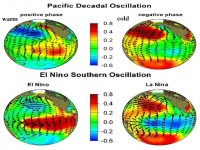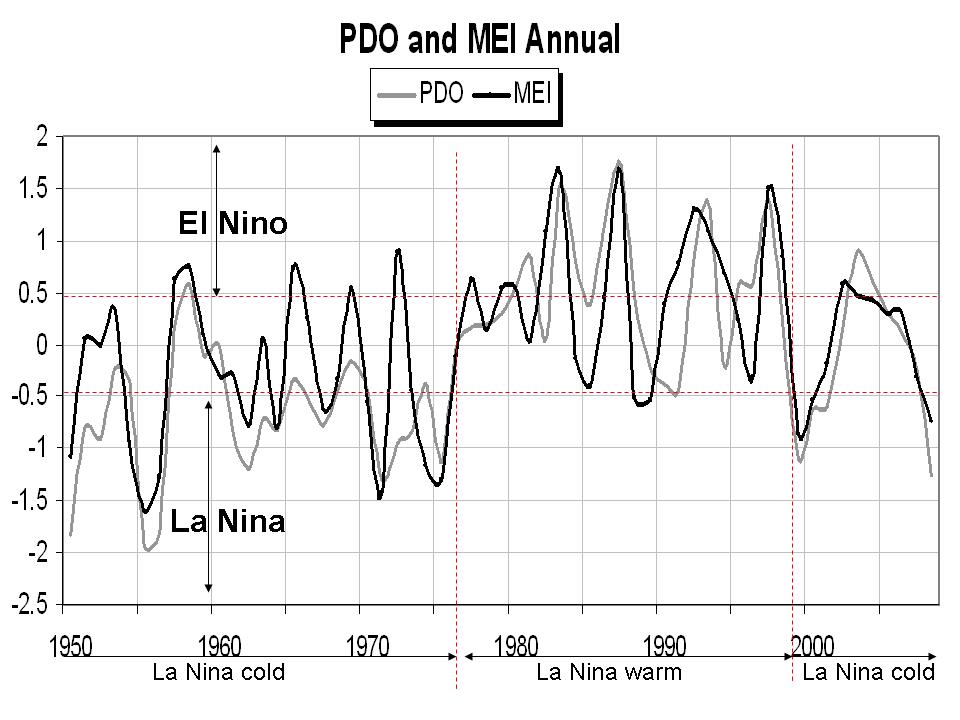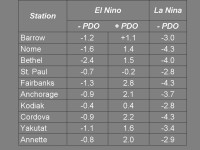By John Papineau, Ph.D, NWS Anchorage, Alaska
The climate of Alaska (i.e. long-term weather patterns) is a product of a number of different external and internal ‘forcings’. Climate varies over time as these forcings change (often small changes). The primary external forcings are: solar output, atmospheric gases (volcanic eruptions, CO2), the temperature of the water in the Pacific Ocean, as well as the strengthening or weakening of ocean currents. Changes in one or several of these forcings typically causes changes within the atmosphere as well (internal forcings), like the repositioning of the polar jet stream and the Aleutian low pressure system or the frequency of La Nina’s and El Nino’s. We will look at some of these forcings in some detail later in this study. Excerpts:
Pacific Decadal Oscillation
In the mid and late 1990’s researchers noticed that fish catches in the Gulf of Alaska seemed to fluctuate on a time scale of roughly 20 to 30 years. Closer investigation showed that sea surface temperatures (SST’s) across the region fluctuated roughly over the same time period (Manuta et al, 1997). The fluctuation from above normal water temperatures to below and vis versa has been termed the Pacific Decadal Oscillation or PDO. When SST’s in the central North Pacific are above normal, SST’s along the coast of Alaska and British Colombia tend to be warmer than normal, this is referred to as the positive phase of the PDO. When SST’s in the central North Pacific are below normal, water temperatures along the coasts are usually below normal (negative phase of the PDO). One phase of the PDO last approximately 20 to 30 years, there are occasions however where the PDO undergoes a 2-5 year mini-reversal, before reverting to its original state.

Combined Forcings
So far we have been considering forcings as individual events, in reality of course they can occur simultaneously - it is this interaction of climate forcings which makes climate research challenging. For example, El Nino’s that occur during the positive phase of the PDO do not have the same impact on temperatures and precipitation across Alaska that the equivalent El Nino would have if the PDO was in a negative phase. In some cases these climate forcings may positively interfere one with another, leading to a very large anomaly, at other times they may have a negative interference, effectively weakening each forcing.
Icecap Note: See the similarity in patterns in PDO and corresponding ENSO states.

In general El Ninos are favored in the positive PDO and La Ninas in the negative phase. That can be seen in the tracking of ENSO (MEI) with PDO here)

El Nino’s that occur when the PDO is negative tend to be slightly cooler when compared to the long-term mean, but the variability is large. During the positive phase of the PDO, El Nino’s tend to be warmer than normal, however there is still considerable variability (in statical terms the standard deviation is large). Notice that La Nina’s which occur during -PDO tend to produce abnormally cooler temperatures, with incidently very little variability. La Nina’s which occur during +PDO are not listed because only one occurred during the 1977-1996 period (which by the way may give some clue about the development of La Nina’s).

Winter temperature anomalies (F) larger version here.
Read much more here. See earlier stories on this Alaska PDO connection here and here and advancing glaciers here.




